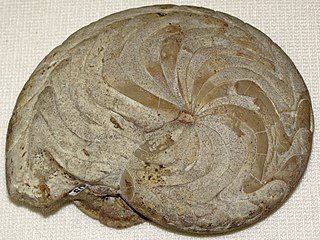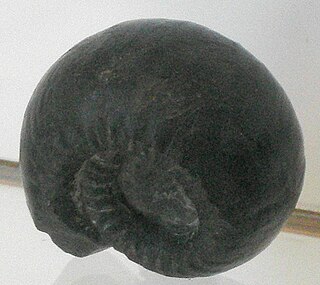Aristoceras is a Late Paleozoic goniatitid genus included in the Goniatitina suborder in which the lobes of the external suture are irregularly serrate.

Prionoceratoidea is a superfamily in the goniatitid suborder, Tornoceratatina that was extant during the latter Paleozoic.
Tornoceratoidea, also known as Tornocerataceae, is a superfamily of goniatitid ammonoids included in the suborder Tornoceratina. Tornoceratoidea, or Tornocerataceae, is essentially the Cheilocerataceae of Miller, Furnish, and Schindewolf (1957) in the Treatise Part L, revised to accommodate new taxa and new perspectives on the phylogeny.
Cycloloboidea is one of seventeen superfamilies of the Goniatitina suborder. They are an extinct group of ammonoid, which are shelled cephalopods related to squids, belemnites, octopodes, and cuttlefish, and more distantly to the nautiloids.
Dimorphoceratoidea is one of seventeen superfamilies included in the ammonoid suborder Goniatitina, a variety of shelled cephalopods that lived during the late Paleozoic.

Gastrioceratoidea is one of 17 superfamilies in the suborder Goniatitina, ammonoid cephalopods from the Late Paleozoic.
Gonioloboceratoidea is one of seventeen superfamilies of the Goniatitina suborder. They are an extinct group of ammonoid, which are shelled cephalopods related to squids, belemnites, octopodes, and cuttlefish, and more distantly to the nautiloids.
Marathonitoidea is one of seventeen superfamilies of the Goniatitina suborder. They are an extinct group of ammonoid, which are shelled cephalopods related to squids, belemnites, octopodes, and cuttlefish, and more distantly to the nautiloids.
Neodimorphoceratoidea is one of seventeen superfamilies of the suborder Goniatitina. They are an extinct group of ammonoid, which are shelled cephalopods related to squids, belemnites, octopuses, and cuttlefish, and more distantly to the nautiloids.

Neoglyphioceratoidea is one of seventeen superfamilies of the Goniatitina suborder. They are an extinct group of ammonoid, which are shelled cephalopods related to squids, belemnites, octopodes, and cuttlefish, and more distantly to the nautiloids.

Neoicoceratoidea, formerly called Neoicocerataceae, is one of seventeen superfamilies of the Goniatitina suborder. Neoicoceratoidea comprises forms previously included in the Neoioceratidae and Metalegoceratidae, previously included in the Goniatitacae. These, along with new families defined for certain genera, including one from the Schistoceratidae, have been recombined as the Neoicocerataceae.
Nomismoceratoidea is one of seventeen superfamilies of the Goniatitina suborder. They are an extinct group of ammonoid, which are shelled cephalopods related to squids, belemnites, octopodes, and cuttlefish, and more distantly to the nautiloids.
Pericycloidea is one of seventeen superfamilies of the Goniatitina suborder. They are an extinct group of ammonoid, which are shelled cephalopods related to squids, belemnites, octopodes, and cuttlefish, and more distantly to the nautiloids.
Popanoceratoidea is one of seventeen superfamilies of the Goniatitina suborder. They are an extinct group of ammonoid, which are shelled cephalopods related to squids, belemnites, octopuses, and cuttlefish, and more distantly to the nautiloids.
Schistoceratoidea is one of seventeen superfamilies of the Goniatitina suborder. They are an extinct group of ammonoid, which are shelled cephalopods related to squids, belemnites, octopuses, and cuttlefish, and more distantly to the nautiloids.
Shumarditoidea is one of seventeen superfamilies of the Goniatitina suborder. They are an extinct group of ammonoid, which are shelled cephalopods related to squids, belemnites, octopuses, and cuttlefish, and more distantly to the nautiloids.
Somoholitoidea is one of seventeen superfamilies of the Goniatitina suborder. They are an extinct group of ammonoid, which are shelled cephalopods related to squids, belemnites, octopodes, and cuttlefish, and more distantly to the nautiloids.
Thalassoceratoidea, formerly Thalassocerataceae, is a superfamily of Late Paleozoic ammonites characterized by their thick-discoidal to subglobular, involute shells with narrow or closed umbilici and biconvex growth striae with ventral sinuses. The ventral lobe of the suture, which straddles the outer rim, is wide, and bifid, with a tall median saddle.

Agoniatitida, also known as the Anarcestida, is the ancestral order within the cephalopod subclass Ammonoidea originating from bactritoid nautiloids, that lived in what would become Africa, Asia, Australia, Europe, and North America during the Devonian from about the lower boundary of Zlichovian stage into Taghanic event during upper middle Givetian, existing for approximately 25 million years.

Clymeniida is an order of ammonoid cephalopods from the Upper Devonian characterized by having an unusual dorsal siphuncle. They measured about 4 cm (1.6 in) in diameter and are most common in Europe, North Africa, and South China but are known from North America and Australia as well.






